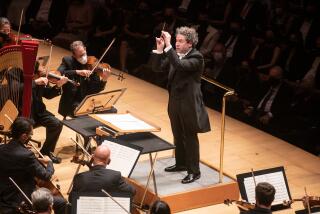An Anton Bruckner convergence in Southern California
In 2011 we will not be celebrating a round-numbered anniversary pertaining to Anton Bruckner (1824-96). The music world will be busy feting Liszt (born 200 years ago) or Gustav Mahler (died 100 years ago).
Nevertheless, the schedules in Southern California converge this month and next, giving us a concentrated hearing of two of this formidable Austrian symphonist’s best works. This week, Carl St.Clair and the Pacific Symphony tackle his craggy, deeply moving, unfinished final testament, the Ninth Symphony. A week later, Gustavo Dudamel and the Los Angeles Philharmonic take on the piece that finally made Bruckner famous in his time — the Seventh Symphony. So let’s call this convergence a mini-festival for Bruckner, whose music, though far better known now than a half-century ago, is still not universally assimilated.
There is an old, handy device — gathering composers into pairs — that classical folk often use to summarize musical eras. In that shorthand spirit, Bruckner and Mahler have been linked as the late German Romantic giants.
As with most oversimplifications, there is some truth in this linkage. Both Bruckner and Mahler staked their legacies upon lengthy, auspicious, visionary symphonies that were often misunderstood and/or ridiculed in their time. Both were heavily influenced by the innovations of Wagner and the long shadow of Beethoven’s Ninth Symphony. Both wrote 11 symphonies (if you count “Das Lied von der Erde” as a symphony, which Mahler did at first), and both died before they could finish their final symphonies — ensuring endless controversy around those who have attempted to complete and perform them. Both began to receive their due in the middle of the 20th century, when the arrival of LP made it feasible to record their huge symphonies.
At this point, their paths diverged. While Mahler’s reputation kept going up and up and up after liftoff in the 1960s, Bruckner’s ascension has stalled and settled into a holding pattern. While Mahler’s music has resonated with our revved-up contemporary times, Bruckner’s conjures a very different world whose patiently developing architecture may be more difficult to absorb in an age of shrinking attention spans. Consequently, while all of Mahler’s symphonies are in “rotation” on the concert playlist, only a handful of Bruckner’s symphonies (Nos. 4, 7, 9, maybe 8) are programmed with any frequency in America.
Mahler was practically fully formed at 20 (as “Das Klagende Lied” shows), but the shy, easily intimidated, devoutly religious Bruckner didn’t hit his stride until well into his 40s, for it took him a long time to accumulate the technique that he thought he would need. He must have had a rueful sense of humor; regarding an early symphony that he didn’t want in his official canon, he called it the Symphony No. 0!
Yet from this meek personality grew a towering mountain range of symphonies. Bruckner finally begins to sound like himself in the scherzo of the “0” Symphony — finished at age 45 — and the Third Symphony, with its gate-storming brass peroration near the close, was his first masterpiece. From there, he seemed to get better and deeper, expanding the scope of the standard four-movement symphonic template, reaching for the infinite in Adagios that grew longer and more mystical. Gradually, he became a prophet, stretching the boundaries of tonality, peering into the century ahead with dissonances that anticipated Schoenberg and an obsession for repeating motives that minimalists wouldn’t associate with a timid 19th century schoolmaster from upper Austria.
There may be two other reasons why Bruckner has not kept pace with Mahler. Some can’t get past the air of piousness that the commonly cited metaphor of a cathedral imposes upon Bruckner symphonies. Also, there is an elusive Bruckner sound, with dark, thick strings and brasses that blaze but never blast, that few orchestras can produce, preferably in a hall with ample but not excessive reverberation and glowing acoustics. I once heard Bruckner’s Fifth in the golden Vienna Musikverein with an Austrian orchestra — and after you’ve experienced Bruckner under these near-ideal conditions, you learn what is possible.
But you don’t have to be Catholic or even religious to get a full charge from Bruckner, because even nonobservant tourists are moved and impressed by the great European cathedrals. And you don’t necessarily have to visit Vienna to receive a credible Bruckner experience.
The L.A. Philharmonic has been lucky to have two first-rate Brucknerians back to back as music directors — Zubin Mehta, who rebuilt the Phil with the dark hardwood sound of the Vienna Philharmonic in mind, and Carlo Maria Giulini, whose broadly paced performances communed deeply with Bruckner the mystic without sacrificing his backbone. Bruno Walter made all of his benchmark Bruckner symphony recordings in 1959-61 in the American Legion Hall on Highland Avenue.
That was long ago, but as recently as 2009, I can recall a couple of outstanding Bruckner performances in Walt Disney Concert Hall — which is a very different species from the Musikverein. Mehta, now a grand old master, led the Vienna Philharmonic in a galvanizing rendition of the Ninth, and Christoph Eschenbach seemed to channel legendary German conductor Wilhelm Fürtwangler with the L.A. Phil in a daringly slow yet ecstatically powerful Seventh. And perhaps an outsider to the tradition like Dudamel can fuse his youthful energy with rapt concentration and help put Bruckner back on the upward arc to the top of the repertoire.
We could use that. Once you’ve tuned into Bruckner’s unique sense of time and space, this dysfunctional world becomes a better place.
More to Read
The biggest entertainment stories
Get our big stories about Hollywood, film, television, music, arts, culture and more right in your inbox as soon as they publish.
You may occasionally receive promotional content from the Los Angeles Times.






